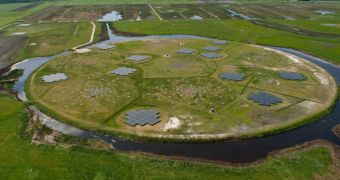The Low Frequency Array (LOFAR) is the most advanced and complex radio telescope ever planned and developed. The installation features in excess of 20,000 radio antennas, spread out over 48 listening stations throughout Europe. This telescope is bound to begin scientific observations soon.
All the antennas that make up LOFAR are connected to each other via the Internet, and also through a series of fiber optics cables that run from one listening station to another. The most remarkable thing about this array is that it will survey the sky in a previously-obscured region of the radio spectrum.
This ability carries with it the promise of allowing radio astronomers to observe the very first galaxies and stars, structures that developed just hundreds of millions of years after the Big Bang. Additionally, the array may also discover the first signals of alien intelligence, Space reports.
In order for LOFAR to function properly, scientists will need to use a supercomputer to combine all data from the installation into a single image. This turns the array into the most versatile telescope for radio observations ever, explains Heino Falcke.
The expert holds an appointment as the chairman of the board for the International LOFAR Telescope. He adds that only 16,000 of LOFAR's antennas are now online, making up around 41 listening stations.
By using radio interferometry, the installation will be able to produce images that will look as if they were collected through a telescope some 620 miles (1,000 kilometers) in diameter. But the good news doesn't stop here.
LOFAR is also “an expandable design – we can always come along later and add additional stations,” explains Netherlands Institute for Radio Astronomy (ASTRON) researchers Michael Wise. Experts say that the instrument can analyze the entire northern hemisphere twice in only 45 days.
One of the machine's primary targets will be the dark age of the Universe, a time when light as we know it had not yet properly formed. “This is a pivotal phase in the early evolution of the Universe, stretching from 400 million to 800 million years after the Big Bang,” Ger de Bruyn says.
“We'd like to know when exactly it happened, how it happened, how fast it happened,” adds the investigator, who is the head of ASTRON.

 14 DAY TRIAL //
14 DAY TRIAL //